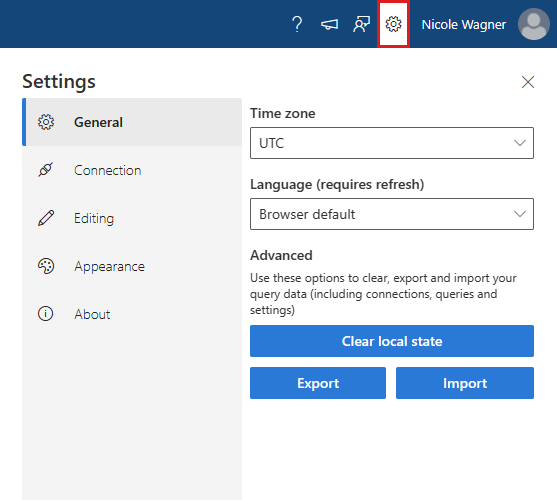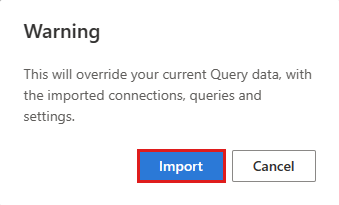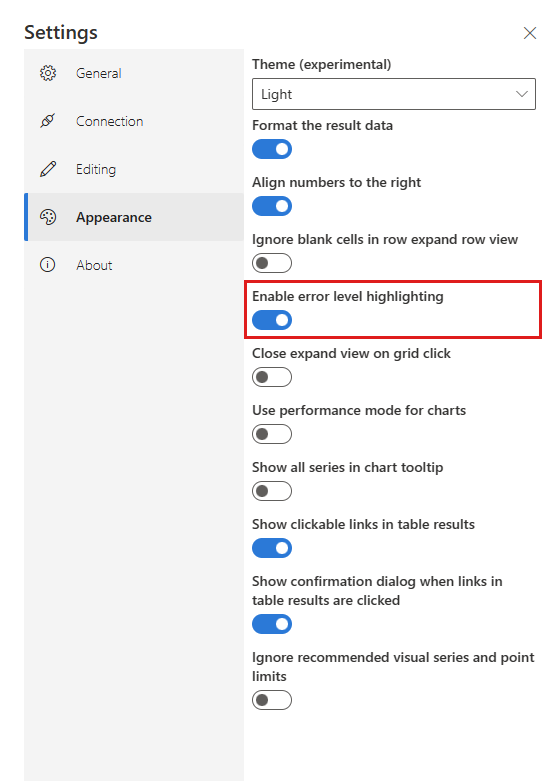Customize settings in the Azure Data Explorer web UI
This article will guide you through the process of customizing settings in the Azure Data Explorer web UI. You'll learn how to export and import environment settings, highlight error levels, and change datetime to specific time zone. This can help you protect your work environment and relocate it to other browsers and devices, as well as make it easier to identify errors.
Prerequisites
- A Microsoft account or a Microsoft Entra user identity. An Azure subscription isn't required.
- Sign in to the Azure Data Explorer web UI.
Go to the settings
Select the settings icon ![]() on the top right, to open the Settings window.
on the top right, to open the Settings window.

Set query recommendations
The query editor provides suggestions and warnings as you write your queries. The suggestions and warnings may be related to performance, correctness, or general best practices. To customize your suggestions and warnings, do the following steps:
In the Settings > Editing window, select Set query recommendations.
In the Set query recommendations dialog box, turn on or off specific Suggestions and Warnings. Use the Activate suggestions and Activate warnings at the top of the respective tabs to turn on or off all of the suggestions or warnings at once.
Select Apply to save the changes.
Adjust timeout limits
Query and admin commands have a default timeout limit. To extend or reduce these limits, do the following steps:
In the Settings > Connection window, adjust the Query timeout or the Admin command timeout.
The changes are automatically saved.
To learn how to set timeout limits outside of the web UI, see Set timeout limits.
Export and import environment settings
The export and import actions help you protect your work environment and relocate it to other browsers and devices. The export action will export all your settings, cluster connections, and query tabs to a JSON file that can be imported into a different browser or device.
Export environment settings
In the Settings > General window, select Export.
The adx-export.json file will be downloaded to your local storage.
Select Clear local state to revert your environment to its original state. This setting deletes all your cluster connections and closes open tabs.
Note
Export only exports query related data. No dashboard data will be exported within the adx-export.json file.
Import environment settings
In the Settings > General window, select Import. Then in Warning pop-up, select Import.

Locate your adx-export.json file from your local storage and open it.
Your previous cluster connections and open tabs are now available.
Note
Import overrides any existing environment settings and data.
Highlight error levels
Azure Data Explorer tries to interpret the severity or verbosity level of each row in the results panel and color them accordingly. It does this by matching the distinct values of each column with a set of known patterns ("Warning", "Error", and so on).
Turn on error level highlighting
To turn on error level highlighting:
Select the Settings icon next to your user name.
Select the Appearance tab and toggle the Enable error level highlighting option to the right.

| Error level color scheme in Light mode | Error level color scheme in Dark mode |
|---|---|

|

|
Column requirements for highlighting
For highlighted error levels, the column must be of data type int, long, or string.
- If the column is of type
longorint:- The column name must be Level
- Values may only include numbers between 1 and 5.
- If the column is of type
string:- The column name can optionally be Level to improve performance.
- The column can only include the following values:
- critical, crit, fatal, assert, high
- error, e
- warning, w, monitor
- information
- verbose, verb, d
Related content
Feedback
Kommer snart: I hele 2024 udfaser vi GitHub-problemer som feedbackmekanisme for indhold og erstatter det med et nyt feedbacksystem. Du kan få flere oplysninger under: https://aka.ms/ContentUserFeedback.
Indsend og få vist feedback om


